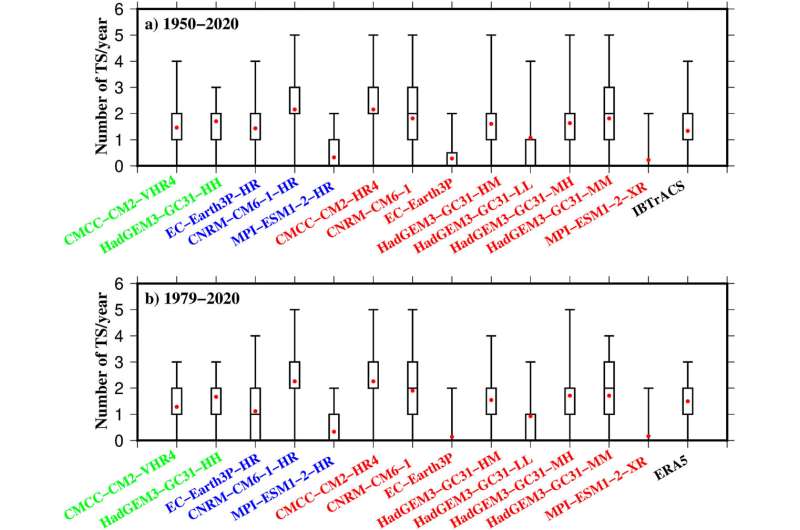This article has been reviewed according to Science X's editorial process and policies. Editors have highlighted the following attributes while ensuring the content's credibility:
fact-checked
peer-reviewed publication
trusted source
proofread
Fewer but more intense tropical storms predicted over the Ganges and Mekong

Climate experts project a decline in the frequency of future tropical storms but an increase in their strength across the Ganges and Mekong basins allowing for better future planning.
The Newcastle University-led team focused on the Ganges and Mekong basins and evaluated the simulation of tropical storms. Their analyses show an increase in tropical storms frequency up until the early 2010s but that climate models project a frequency decline of over 50% on average across both basins by 2050.
In contrast, the results from high resolution climate models show an increase in the future intensity of tropical storms for both basins, with the largest increases for the most intense tropical storms.
These findings can be used to assess the future resilience of existing infrastructure systems to tropical storms across these densely populated basins.
The team, involving scientists from the Met Office and the University of Reading, published their findings in the journal Geophysical Research Letters. The scientists used European Union Horizon 2020 project PRIMAVERA models, which are available at up to 25 km resolution. They also employed two storm tracking algorithms, TRACK and TempExt.
Study lead author, Dr. Haider Ali, of Newcastle University's School of Engineering, said, "Tropical storms are one of the world's most damaging natural hazards which result in colossal socioeconomic losses to life, infrastructure and property, especially in low-lying delta rivers basins like the Ganges and Mekong."
"Knowledge of changes to tropical storms activity under climate change can therefore be helpful in developing better disaster risk mitigation and for climate adaptation. Previous modeling studies have used coarse-resolution global climate models unable to capture key tropical storm characteristics."
"In this study, we used finer resolution models and two different tracking algorithms to resolve a part of this uncertainty."
Study author, Hayley Fowler, Professor of Climate Change Impacts, Newcastle University School of Engineering, added, "Our results are consistent with those found for tropical storms and Tropical Cyclones in the Atlantic Basin, where they also project an overall decline in frequency but an increase in the frequency of the most intense TCs. These systems cause massive impacts on society from high winds, rainfall and storm surges causing flooding. Quantifying these changes will allow us to better plan for future events."
Implications for climate adaptation policies
The Ganges and Mekong basins are two significant river systems in Asia that play vital roles in the lives of millions of people living in the region. The basins are essential for agriculture, water supply, and transportation.
However, both the Ganges and Mekong basins are highly vulnerable to the impacts of climate change, including changes in precipitation patterns, extreme weather events, and sea-level rise.
The authors say that developing our knowledge about the characteristics of future tropical storms is crucial in informing climate adaptation strategies to safeguard communities and critical infrastructure. They add that understanding changes to tropical storm activity in the future can support effective adaptation planning and risk assessment, particularly in densely populated low-lying delta rivers basins like the Ganges and Mekong.
More information: Haider Ali et al, Fewer, but More Intense, Future Tropical Storms Over the Ganges and Mekong Basins, Geophysical Research Letters (2023). DOI: 10.1029/2023GL104973
Journal information: Geophysical Research Letters
Provided by Newcastle University





















